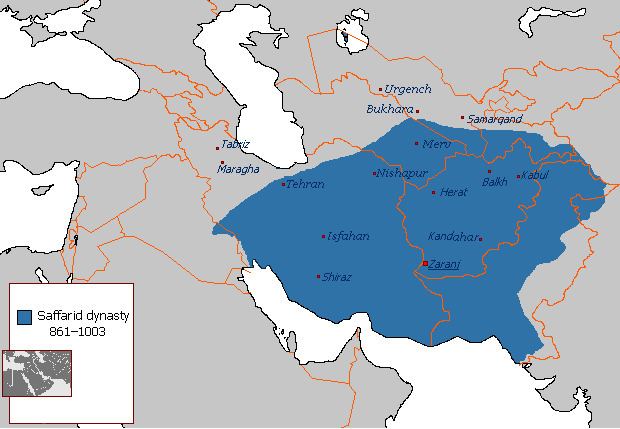963–1002 Khalaf I | Government Monarchy | |
 | ||
861–879 Ya'qub bin Laith as-Saffar | ||
The Saffarid dynasty (Persian: سلسله صفاریان) was a Muslim Persianate dynasty from Sistan that ruled over parts of eastern Iran, with its capital at Zaranj (a city now in southwestern Afghanistan). Khorasan, Afghanistan and Sistan from 861 to 1003. The dynasty, of Persian origin, was founded by Ya'qub bin Laith as-Saffar, born in 840 in a small town called Karnin (Qarnin), which was located east of Zaranj and west of Bost, in what is now Afghanistan - a native of Sistan and a local ayyar, who worked as a coppersmith (ṣaffār) before becoming a warlord. He seized control of the Sistan region and began conquering most of Iran and Afghanistan, as well as parts of Pakistan, Tajikestan and Uzbekistan.
Contents
The Saffarids used their capital Zaranj as a base for an aggressive expansion eastward and westward. They first invaded the areas south of the Hindu Kush in Afghanistan and then overthrew the Persian Tahirid dynasty, annexing Khorasan in 873. By the time of Ya'qub's death, he had conquered the Kabul Valley, Sindh, Tocharistan, Makran (Balochistan), Kerman, Fars, Khorasan, and nearly reached Baghdad but then suffered a defeat by the Abbasids.
The Saffarid empire did not last long after Ya'qub's death. His brother and successor, Amr bin Laith, was defeated at the Battle of Balkh against Ismail Samani in 900. Amr bin Laith was forced to surrender most of his territories to the new rulers. The Saffarids were subsequently confined to their heartland of Sistan, with their role reduced to that of vassals of the Samanids and their successors.
Founding
The dynasty began with Ya'qub ibn al-Layth al-Saffar (Ya'qub, son of Layth, the Coppersmith), a coppersmith who moved to the city of Zaranj. He left work to become an Ayyar and eventually got the power to act as an independent ruler. From his capital Zaranj he moved east into al-Rukhkhadj and Zamindawar followed by Zunbil and Kabul by 865. He then invaded Bamyan, Balkh, Badghis, and Ghor. In the name of Islam, he conquered these territories which were ruled mostly by Buddhist tribal chiefs. He took vast amounts of plunder and slaves from this campaign. Nancy Dupree in her book An Historical Guide to Afghanistan describes Yaqub's conquests as such:
Arab armies carrying the banner of Islam came out of the west to defeat the Sasanians in 642 and then they marched with confidence to the east. On the western periphery of the Afghan area the princes of Herat and Sistan gave way to rule by Arab governors but in the east, in the mountains, cities submitted only to rise in revolt and the hastily converted returned to their old beliefs once the armies passed. The harshness and avariciousness of Arab rule produced such unrest, however, that once the waning power of the Caliphate became apparent, native rulers once again established themselves independent. Among these Saffarids of Sistan shone briefly in the Afghan area. The fanatic founder of this dynasty, the coppersmith’s apprentice Yaqub ibn Layth Saffari, came forth from his capital at Zaranj in 870 and marched through Bost, Kandahar, Ghazni, Kabul, Bamyan, Balkh and Herat, conquering in the name of Islam.
The Tahirid city of Herat was captured in 870 and his campaign in the Badghis region led to the capture of Kharidjites which later formed the Djash al-Shurat contingent in his army. Ya'qub then turned his focus to the west and began attacks on Khorasan, Khuzestan, Kerman (Southeastern Iran) and Fars (southwestern Iran). The Saffarids then seized Khuzestan (southwestern Iran) and parts of southern Iraq, and in 876 came close to overthrowing the Abbasids, whose army was able to turn them back only within a few days' march from Baghdad. These incursions, however, forced the Abbasid caliphate to recognize Ya'qub as governor of Sistan, Fars and Kerman, and Saffarids were even offered key posts in Baghdad.
In 901, Amr Saffari was defeated at the battle of Balkh by the Persian Samanids, which reduced the Saffarid dynasty to a minor tributary in Sistan.
In 1002, Mahmud of Ghazni invaded Sistan, dethroned Khalaf I and finally ended the Saffarid dynasty.
Culture
The Saffarids gave great care to the Persian culture. Under their rule, the eastern Islamic world witnessed the emergence of prominent Persian poets such as Fayrouz Mashriqi, Abu Salik al-Jirjani, and Muhammad bin Wasif al-Sistani, who was a court poet.
In the later 9th century, the Saffarids gave impetus to a renaissance of New Persian literature and culture. Following Ya'qub's conquest of Herat, some poets chose to celebrate his victory in Arabic, whereupon Ya'qub requested his secretary, Muhammad bin Wasif al-Sistani, to compose those verses in Persian.
From silver mines in the Panjshir Valley, the Saffarids were able to mint silver coins.
